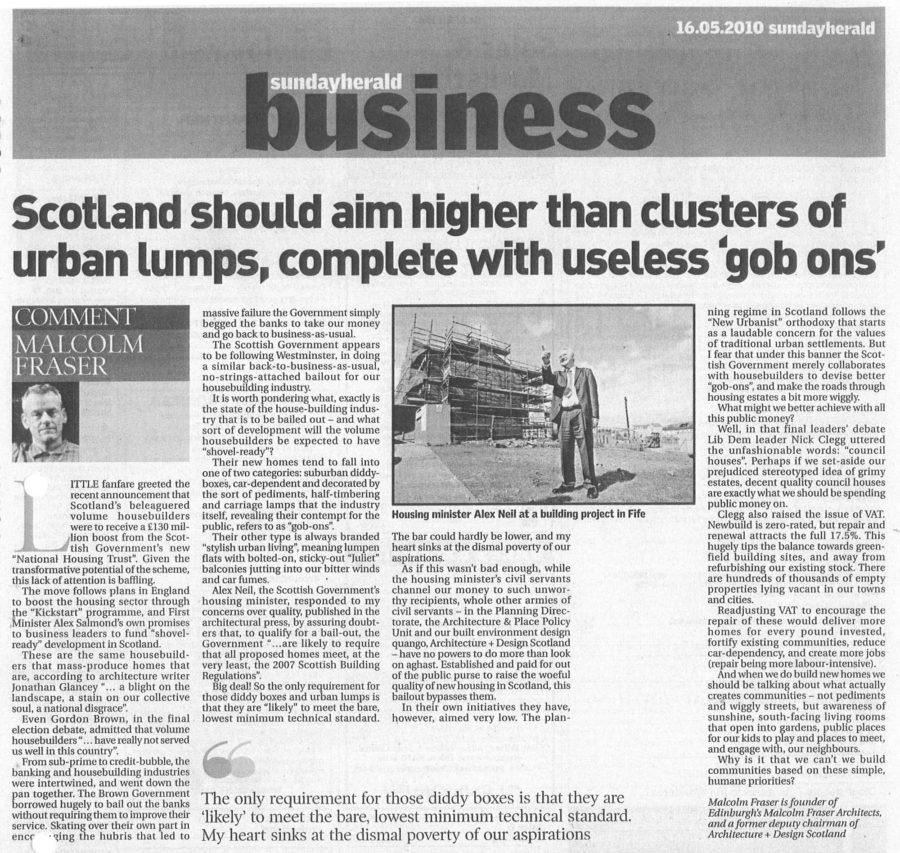Little fanfare greeted the announcement that Scotland’s beleaguered housebuilders were to receive a £130 million boost from the Scottish Government’s new “National Housing Trust”. Given the transformative potential such major public funding brings, this is puzzling.
The move follows plans in England to “Kickstart” the housing sector, and First Minister Alex Salmond’s own promises to fund “shovel-ready” development in Scotland.
Of course, these are the same housebuilders that produce homes that are, in the words of respected architecture writer Jonathan Glancey “… a blight on the landscape, a stain on our collective soul, a national disgrace” – and that even Gordon Brown, in the final Leaders’ Debate, admitted “…have really not served us well in this country”.
From sub-prime to credit-bubbles, the banking and housebuilding industries are intertwined, and went down together. The Government borrowed hugely, on our behalf, to bail-out the Banks, but it did not use the power this gave them, to require them to improve their service or regulate their endemic tendency to hubris and failure, and simply begged them to take our money and go back to business-as-usual.
It’s now doing something similar for our housebuilding industry. It’s a back-to-business-as-usual, no-strings-attached, bailout.
Publication / Sunday Herald
Piece commissioned by the Sunday Herald in response to a Scottish Government announcement for a massive funding boost to the private market.
It’s worth pondering what, exactly, will be bailed-out – what sort of development will the housebuilders have “shovel-ready”. Almost all new homes fall into one of two categories: suburban diddy-boxes, car-dependent and decorated by the sort of pediments, half-timbering and carriage lamps that the industry itself charmingly refers-to as “gob-ons”; or “stylish urban living” lumpen flats, with bolted on “Juliet” balconies stuck-out into bitter gales and car fumes.
Alex Neil, our Housing Minister, responded to my concerns over quality by assuring us that a bailed-out development’s criteria “…are likely to require that all proposed homes meet, at the very least, the 2007 Scottish Building Regulations”. So, there we have it, diddy boxes and urban lumps that are, at best, “likely” to meet the bare, lowest minimum technical standard. Likely! The bar could hardly be lower and my wee heart sinks at our stunted aspirations.
That we, as a nation, are continuing to roll-out this “national disgrace” is one thing; but that we are now borrowing to publicly-bankroll it, is quite another.
But alongside this great irony is another, for while the Housing Minister’s civil servants channel our money to such unworthy recipients whole other armies of civil servants – in the Planning Directorate, the Architecture and Place Policy Unit and our built environment design Quango, Architecture and Design Scotland – must be looking-on aghast. Set-up and paid – out of public funds again, of course – to raise the “woeful and cynical” quality of new housing in Scotland, they are being entirely bypassed by this bailout.
They have, however, aimed very low, up to now. The Planning regime in Scotland follows the “New Urbanist” orthodoxy. This starts as a laudable concern for the qualities which have created traditional towns. But under this banner the Scottish Government, and bodies like the Prince of Wales’ Foundation for the Built Environment, work closely with the more amenable housebuilders to “transform Scotland’s new housing” – to improve the quality of Greenfield “gob-ons” and make the roads through new housing estates a bit more wiggly.
If this reads like me being unduly cynical let me guide you, first, to the Scottish “Sustainable Communities Initiative” – “so-called eco-towns” to you and me – of which the majority are commuter towns or suburbs built on farmland; or to places like Ellon, and Ballater, where the Prince’s Foundation is working with Scotia Homes, and has objected to local authorities’ plans to protect the countryside, and forced others to allocate up to 254 houses on meadows where they had thought 25 were reasonable.
To sell this sort of developments to communities the Government is spending a sum, reported to be £200,000, on American design guru Andres Duany, who has flown over Scotland and thinks there’s lots of room, so building on the countryside is just fine. Again, his analysis of traditional settlements is good, and his charismatic approach succeeds in engaging local people in looking at the virtues of their own environment.
But I have yet to see any output from all this more sophisticated than the view that local people prefer the look of Granny’s Heilan’ Hame to the Red Road Flats. So that what we need is housebuilders who can provide a better class of pediment, and maybe even a crowstep gable, on their greenfield diddy-boxes.
So, is there an alternative to bail-outs and (a better class of) gob-ons, that we might achieve with our public money?
Well, in the same final Leaders’ Debate Nick Clegg uttered these so-unfashionable words: “Council Houses”. Perhaps if we set-aside our prejudices, and our disdain for grimy estates, it’s just a simple description of what we should build – this time with the real needs and aspirations fully at the heart of how we design – for the most-needy and worthy, if we are using public money.
He also raised the issue of VAT. Zero-rated for newbuild, and at the full 17.5% for repair and renewal, it hugely tips the playingfield towards these greenfield estates, and away from refurbishing our existing stock. As Clegg pointed out, there are hundreds of thousands of empty properties lying vacant in our towns and cities. Readjusting VAT, to assist with the repair of these, would deliver more homes for every pound invested, fortify existing communities, reduce car-dependency, create more jobs (repair being more labour-intensive) and give significant assistance to sustainability and carbon-reduction targets. . It would also do hugely more for the traditional urban communities that the Scottish Government’s Planners, Directorates, Policy Units and Quangos say they care for, than better gob-ons and wiggly-roads in greenfield estates would.
And when we do build new homes I’d suggest that we raise our sights, from the current orthodoxy to talking about the simple utilitarian patterns that really create communities – which is not pediments and wiggly streets, but caring for sunshine, and playspaces and places to meet your neighbours, and south-facing living rooms and amenity spaces and the like.
Why can’t we build communities out of these simple objectives? And, in particular, if we, the public, are paying for new communities out of our pockets, why won’t our Government demand this, for us?


